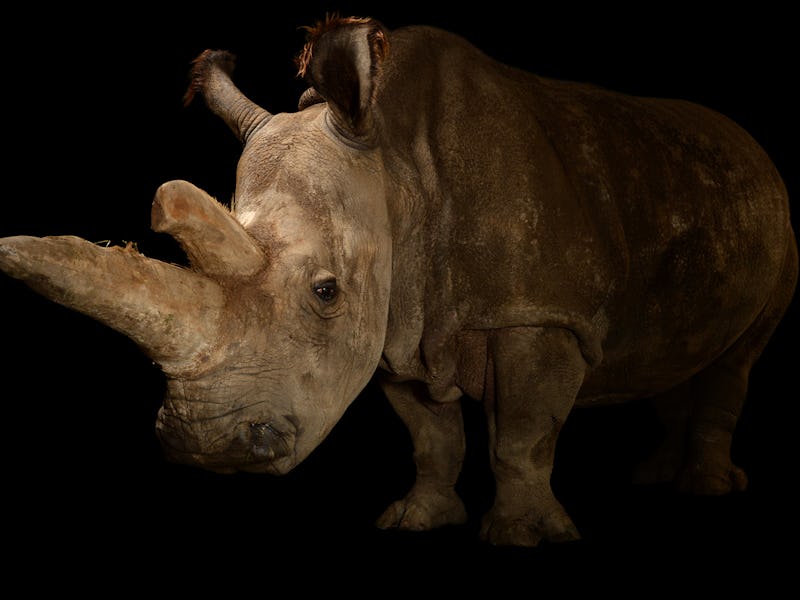After Death of Last Male Northern White Rhino, One Survival Method Remains
'I think it's reasonable to try it."

After declining health prompted by a serious leg infection, Sudan, the world’s last male northern white rhino, died in Kenya on Monday. The beloved 45-year-old leaves behind the last two members of the entire species: two females, Najin and Fatu, who still live at the Ol Pejeta Conservancy. There’s still one last chance that this species won’t go extinct entirely, but it rests on a very risky reproductive strategy.
On a Skype call with Inverse, Jan Stejskal, director of international projects at the Czech Republic-based Dvur Králové Zoo, where Sudan was first raised as a young rhino, explained how science is our last hope for saving this species.
“We know that we really have to focus on artificial reproduction techniques to save northern white rhinos,” he says. “To give them a chance to live with us here, where they belong.”
The rhinoceros situation at the Ol Pejeta Conservancy will not make artificial reproduction easy. To produce a viable rhino infant, scientists there will need to find a way to put together rhino eggs and sperm and then insert the embryo into a surrogate mother. The resources for doing so are far from ideal: Sudan, the last male, is gone; while he was alive, he failed to mate with either Najin or her daughter, Fatu. In 2014, Stejskal and his team discovered that Fatu had pathological changes to her endometrium that made her sterile, and Najin’s injured hind legs make her unfit to carry an infant in her womb.
But there is a stockpile of frozen sperm from Sudan and five other males, and the eggs of the remaining females may still be viable. If the eggs can be fertilized, the resulting embryo can be inserted into the womb of a different but closely related species — the southern white rhino — in hopes that she can bring the calf to term.
Nabiré, a northern white rhino female that died at Dvůr Králové in the Czech Republic in 2015. Two females in Kenya are the last of their species.
Two methods can get the scientists the eggs they need. “You need to somehow achieve embryo in vitro,” explains Stejskal. “This is a crucial thing for success. One way, through harvesting oocytes from live donors. The other way is you would achieve eggs or sperm through stem cell research.”
Harvesting oocytes is a technique that’s commonly used in commercial farming among horses and cows, but it’s much harder to do in rhinos, says Stejskal, because the animals are just so much bigger.
“It’s much more complicated to reach and harvest oocytes [in rhinos],” he says. “You have to develop specific tools or prototypes for this procedure.”
Fortunately, scientists in Berlin and elsewhere, studying rhinos in European zoos, have figured out how to harvest oocytes safely. He added: “I would say this procedure, we have a pretty high chance it will be successful. I think it’s reasonable to try it.”
If the scientists can safely retrieve the eggs, the next step will be to fertilize them with the frozen sperm. Italian scientists at Avantea, a veterinary assisted-reproduction company in Cremona, are “very close” to making a rhino embryo in this way, says Stejskal, so if his team does succeed in harvesting eggs from the female rhinos in Ol Pejeta, they’ll have to be be transported to Italy for fertilization “as soon as possible.”
Two options remain for creating a rhino embryo: collecting eggs from the remaining females or creating them from stem cells.
Then there’s the more complicated, experimental option: growing both eggs and sperm by manipulating stem cells. Stem cells, found naturally in embryos, give rise to all the different types of cells in the body. In recent years, scientists have made great advances in taking adult cells — say, a skin cell or liver cell — and rewinding their development so they turn back into stem cells, which can then be manipulated to become cells of any other type. This is how scientists think they might be able to use existing rhino cells to create rhino eggs and sperm, which can then be put together to produce an implantable embryo.
Complicated as it sounds, Stejskal says “it’s feasible to try.” Scientists have already shown that induced pluripotent stem cells can be produced from northern white rhinos, and some have even been able to turn stem cells from a dead rhino into heart muscle cells. “It’s a symbol of hope that these cellular technologies could give the northern white rhinos a chance to survive.”
In the next few months, Stejskal hopes his team can safely harvest eggs from the northern white rhino females at Ol Pejeta, fly them to Italy, and generate the embryos that will save this imperiled population. Encouraged by the success we’ve made in reproductive technology that boosts human fertility, he thinks the same can be done for the northern white rhinos and other near-extinct species.
“I would say that this part of medicine or biology is moving fast forward because of human medicine,” he says. “But again, why not try something you’d work on anyway and utilize it to help probably the most endangered mammal that shares the planet with us now?”